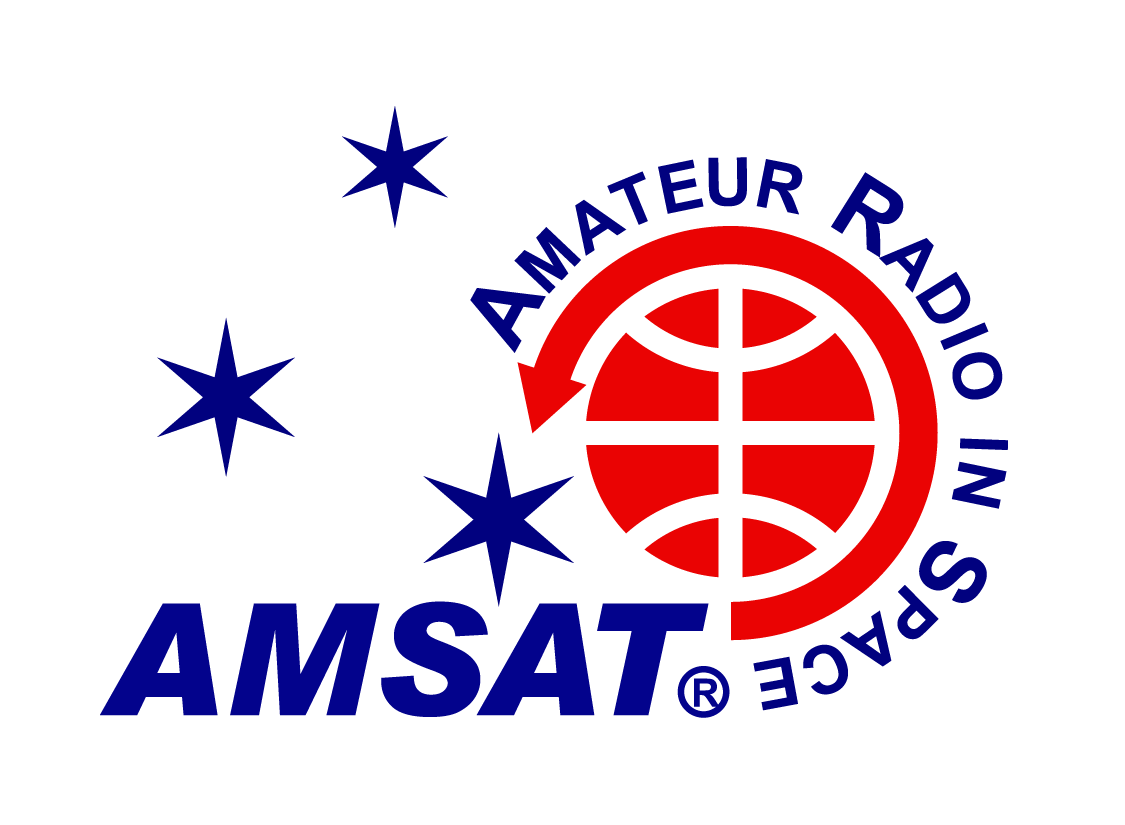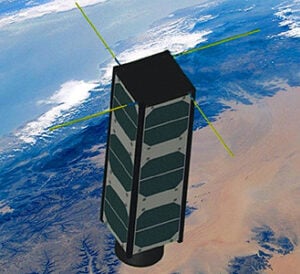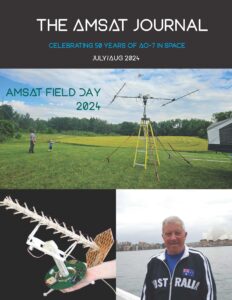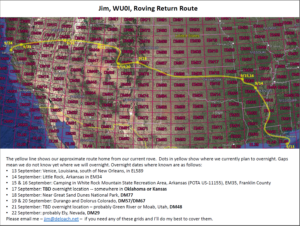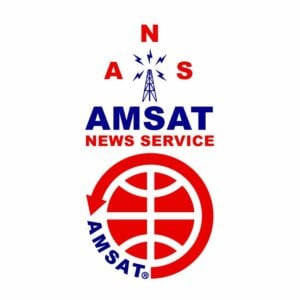
AMSAT News Service
ANS-287
October 13, 2024
In this edition:
- Status Note – 42nd Annual AMSAT Space Symposium and Annual General Meeting
- Final Call for Papers
- ARISS SSTV Event Continues Until Monday October 14
- Call for ARISS Proposals From U.S. Educators
- Changes to AMSAT TLE Distribution for October 10, 2024
- ARISS News
- Upcoming Satellite Operations
- AMSAT Ambassador Activities
- Satellite Shorts From All Over
The AMSAT News Service bulletins are a free, weekly news and information service of AMSAT, The Radio Amateur Satellite Corporation. ANS publishes news related to Amateur Radio in Space including reports on the activities of a worldwide group of Amateur Radio operators who share an active interest in designing, building, launching and communicating through analog and digital Amateur Radio satellites.
The news feed on https://www.amsat.org publishes news of Amateur Radio in Space as soon as our volunteers can post it.
Please send any amateur satellite news or reports to: ans-editor [at] amsat.org
You can sign up for free e-mail delivery of the AMSAT News Service Bulletins via the ANS List; to join this list see: https://mailman.amsat.org/postorius/lists/ans.amsat.org/
Status Note – 42nd Annual AMSAT Space Symposium and Annual General Meeting

Hurricane Milton impacted the Tampa area on October 9th and 10th. As recovery from the storm continues, the AMSAT Symposium team will be in communication with hotel representatives as soon as possible to determine whether the Symposium will be able to proceed as planned. We will let all registrants know the status as soon as possible. If the in-person Symposium is canceled, we will hold a virtual event on Saturday, October 26th.
The 42nd Annual AMSAT Space Symposium and Annual General Meeting will be held on Friday through Saturday, October 25-26, 2024, at the DoubleTree by Hilton Tampa Rocky Point Waterfront in Tampa, Florida.
Highlights of all scheduled events include:
- AMSAT Board of Directors Meeting, October 24-25
- 42nd AMSAT Space Symposium and Annual General Meeting, October 25-26
- Friday Night Social and Auction, October 25
- AMSAT Banquet and Reception, October 26
- AMSAT Ambassador Breakfast (all are welcome), October 27
Note – if you wish to register guests for the banquet and/or breakfast who are not attending the Symposium sessions, you must register for each event separately and include your guests with your banquet and breakfast tickets.
If you are interested in presenting or submitting a paper for inclusion in the Symposium Proceedings, please see the Call for Papers.
IMPORTANT: The deadline for Symposium registrations if you want to include the Saturday evening banquet or Sunday breakfast is Friday, October 18th. Meals cannot be ordered after that date.
Click Here to Register Now
Hotel Reservations
The rate for a standard room with two Queen beds is $169.00 plus state and local taxes of 14.5%. Rooms may be available for check-in on Wednesday, October 23 and check out Sunday, October 27.
Rooms can be reserved at https://www.hilton.com/en/attend-my-event/radioamateursatellite/.
Reservations may also be made by phone at 813-888-8800. Reference AMSAT to receive the group rate.
Note: If you are planning on driving to the Symposium or renting a car, parking charges are $20 per night for overnight parking.
We, at AMSAT, are excited to be able to host our 42nd annual Symposium this year. We hope that you can join us in celebrating Amateur Radio in Space.
Schedule
Thursday, October 24, 2024
8:00 AM – 6:00 PM AMSAT Board Meeting
6:00 PM – 8:00 PM Pre-Registration Check-in
Friday, October 25, 2024
8:00 AM – 12:00 Noon AMSAT Board Meeting (Closed Session)
9:00 AM – 4:00 PM Registration
1:00 PM – 1:15 PM AMSAT Symposium Kickoff, President’s Welcome
1:15 PM – 5:00 PM Paper Sessions
5:00 PM – 7:00 PM Informal Dinner on your own
7:00 PM – 9:00 PM AMSAT Reception and Auction, Cash Bar Available
Saturday, October 26, 2024
8:00 AM – 11:45 AM Registration
8:00 AM – 8:15 AM AMSAT Symposium Welcome
8:15 AM – 12:00 Noon Paper Sessions
1:00 PM – 3:15 PM Paper Sessions
3:30 PM – 4:45 PM AMSAT Annual Meeting & Awards Ceremony
6:00 PM – 7:00 PM Attitude Adjustment (Social), Cash Bar
7:00 PM – 10:00 PM AMSAT Banquet, Cash Bar
Sunday, October 27, 2024
7:30 AM – 9:00 AM AMSAT Ambassador Breakfast (All are welcome)
[ANS thanks the AMSAT Symposium Committee for the above information]
Final Call for Papers
Papers continue to be accepted for the 42nd annual AMSAT Space Symposium to be held on the weekend of October 25-27, 2024 at the Doubletree by Hilton Tampa Rocky Point Waterfront in Tampa, Florida.
Proposals for symposium papers and presentations are invited on any topic of interest to the amateur satellite community. We request a tentative title of your presentation as soon as possible, with final copy submitted by October 18 for inclusion in the symposium proceedings. Abstracts and papers should be sent to Dan Schultz, N8FGV at [email protected]
[ANS thanks Dan Schultz, N8FGV, AMSAT Symposium Proceedings Editor for the above information]
ARISS SSTV Event Continues Until Monday October 14
ARISS is planning a Slow Scan Television (SSTV) experiment from the International Space Station started this past Tuesday and is scheduled to run until Monday, October 14, at 14:10 GMT.
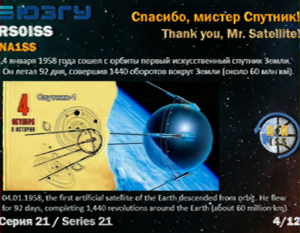
The transmission frequency will be 145.800 MHz FM, using SSTV mode PD120. The ISS callsign will be RS0ISS.
The SSTV transmissions will be made using the station in the Russian ISS Service Module. The equipment used is a Kenwood D710 transceiver running about 25 watts output which provides a very strong signal enabling reception using simple equipment. Images received by amateurs world-wide during previous transmissions can be seen at http://www.spaceflightsoftware.com/ARISS_SSTV.
Amateurs can receive the SSTV pictures directly from the space station by connecting the audio output of their two-meter transceiver via a simple interface to the soundcard on a Windows PC or an Apple iOS device. On Windows PC’s the free application MMSSTV can be used to decode the signal, on Apple iOS devices you can use the SSTV app for compatible modes. For Linux systems try QSSTV.
The ISS puts out a strong signal so even a 2M handheld with a 1/4 wave antenna will be enough to receive it but one’s chances of success are significantly improved with the use of a handheld beam antenna. The FM transmission uses 5 kHz deviation which is standard in much of the world. Many FM rigs can be switched been wide and narrow deviation FM filters. For best results you should select the filter for wider deviation FM. Handhelds all seem to have a single wide filter fitted as standard.
Reports are requested: please send ARISS uploading your decoded pictures in the official ARISS SSTV gallery: https://www.spaceflightsoftware.com/ARISS_SSTV/
An SSTV Award is also available. To get this award one should receive and decode at least one picture in the session. The quality of the received image does not have to be perfect, but good enough to be able to identify. Rules for earning the award are available at https://ariss.pzk.org.pl/sstv/
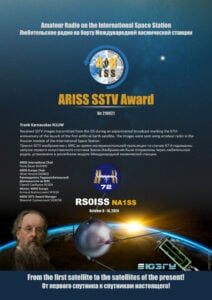
Useful information to receive the pictures can be found here at https://amsat-uk.org/beginners/iss-sstv/
Follow ARISS on X for official updates during the event https://x.com/ARISS_Intl.
[ANS thanks ARISS and AMSAT-UK for the above information]
2024 Coins Are Still Available!
Help Support GOLF and Fox Plus.
Join the AMSAT President’s Club today!
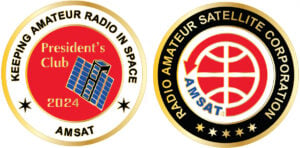
Call for ARISS Proposals from U.S. Educators
The Amateur Radio on the International Space Station (ARISS) Program is seeking formal and informal education institutions and organizations, individually or working together, to host an Amateur Radio contact with a crew member on board the ISS. ARISS anticipates that the contact would be held between July 1, 2025 and December 31, 2025. Crew scheduling and ISS orbits will determine the exact contact dates. To maximize these radio contact opportunities, ARISS is looking for organizations that will draw large numbers of participants and integrate the contact into a well-developed education plan.
The deadline to submit a proposal is November 17th, 2024. Proposal information and more details such as expectations, proposal guidelines and the proposal form can be found at www.ariss.org. An ARISS Introductory Webinar session will be held on Wednesday, October 16 at 7 PM ET. The Zoom link to sign up is: https://us06web.zoom.us/meeting/register/tZcpfuqpqzwiGdSZl0IXCPV6XP2OznBnaOIN
The Opportunity
Crew members aboard the International Space Station will participate in scheduled Amateur Radio contacts. These radio contacts are approximately 10 minutes in length and allow students to interact with the astronauts through a question-and-answer session.
An ARISS contact is a voice-only communication opportunity via Amateur Radio between astronauts and cosmonauts aboard the space station and classrooms and communities. ARISS contacts afford education audiences the opportunity to learn firsthand from astronauts what it is like to live and work in space and to learn about space research conducted on the ISS. Students also will have an opportunity to learn about satellite communication, wireless technology, and radio science. Because of the nature of human spaceflight and the complexity of scheduling activities aboard the ISS, organizations must demonstrate flexibility to accommodate changes in dates and times of the radio contact.
Amateur Radio organizations around the world with the support of NASA and space agencies in Russia, Canada, Japan and Europe present educational organizations with this opportunity. The ham radio organizations’ volunteer efforts provide the equipment and operational support to enable communication between crew on the ISS and students around the world using Amateur Radio.
Please direct any questions to education at ariss-usa.org .
[ANS thanks ARISS for the above information]
Changes to AMSAT TLE Distribution for October 10, 2024
Two Line Elements or TLEs, often referred to as Keplerian elements or keps in the amateur community, are the inputs to the SGP4 standard mathematical model of spacecraft orbits used by most amateur tracking programs. Weekly updates are completely adequate for most amateur satellites. TLE bulletin files are updated Thursday evenings around 2300 UTC, or more frequently if new high interest satellites are launched. More information may be found at https://www.amsat.org/keplerian-elements-resources/
CIRBE NORAD Cat ID 56188 Decayed from orbit on or about 04 October 2024
[ANS thanks Joe Fitzgerald, KM1P, AMSAT Orbital Elements Manager, for the above information]
Need new satellite antennas?
Purchase an M2 LEO-Pack from the AMSAT Store!
When you purchase through AMSAT, a portion of the proceeds goes towards Keeping Amateur Radio in Space.
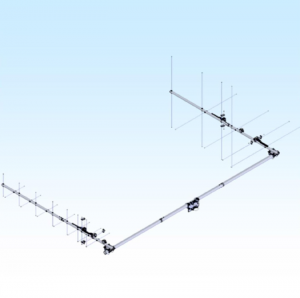
ARISS News
Amateurs and others around the world may listen in on contacts between amateurs operating in schools and allowing students to interact with astronauts and cosmonauts aboard the International Space Station. The downlink frequency on which to listen is 145.800 MHz worldwide.
Istituto Comprensivo “Elena Lucrezua Corner”, Fossò, Italy, direct via IQ3RW
The ISS callsign is presently scheduled to be OR4ISS
The scheduled crewmember is Sunita Williams KD5PLB
The ARISS mentor is IZ2GOJ
Contact is go for: Fri 2024-10-18 09:12:01 UTC 42 deg
Colegio Cervantes, Torreon. Mexico, Telebridge via K6DUE (***)
The ISS callsign is presently scheduled to be OR4ISS
The scheduled crewmember is Nick Hague KG5TMV
The ARISS mentor is VE3TBD
Contact is go for: Fri 2024-10-18 17:02:04 UTC 63 deg
TEACH-NW Charter School, Springfield, OR, direct via KJ7NLL
The ISS callsign is presently scheduled to be NA1SS
The scheduled crewmember is Sunita Williams KD5PLB KD5MDT
The ARISS mentor is W4NTR
Contact is go for: Fri 2024-10-18 18:30:14 UTC 57 deg
Watch for Livestream at https://www.youtube.com/@KJ7NLL/streams
As always, if there is an EVA, a docking, or an undocking; the ARISS radios are turned off as part of the safety protocol.
The crossband repeater continues to be active (145.990 MHz up {PL 67} & 437.800 MHz down), If any crewmember is so inclined, all they have to do is pick up the microphone, raise the volume up, and talk on the crossband repeater. So give a listen, you just never know.
Note, all times are approximate. It is recommended that you do your own orbital prediction or start listening about 10 minutes before the listed time.
The latest information on the operation mode can be found at https://www.ariss.org/current-status-of-iss-stations.html
The latest list of frequencies in use can be found at https://www.ariss.org/contact-the-iss.html
[ANS thanks Charlie Sufana, AJ9N, one of the ARISS operation team mentors for the above information]
Upcoming Satellite Operations
A growing number of satellite rovers are currently engaged in sharing their grid square activations on https://hams.at. By visiting the website, you gain easy access to comprehensive information about the operators responsible for activating specific grid squares. Additionally, you have the ability to assess the match score between yourself and a particular rover for a given pass, while also being able to identify the upcoming satellite passes that are accessible from your location.
Guyana: Aldir, PY1SAD (ZZ1M), operates from Georgetown as 8R1TM between Oct. 12 and Nov. 24 on 160-10m (CW, SSB, digital modes) and via satellites. QSL via LoTW, eQSL, qrz.com. (From DXNL 2427 – October 9, 2024)
[ANS thanks Ian Parsons, K5ZM, AMSAT Rover Page Manager, for the above information]
Want to fly the colors on your own grid expedition?
Get an AMSAT car flag and other neat stuff from our Zazzle store!
25% of the purchase price of each product goes towards Keeping Amateur Radio in Space
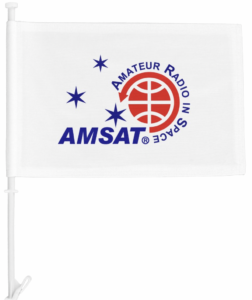
AMSAT Ambassador Activities
AMSAT Ambassadors provide presentations, demonstrate communicating through amateur satellites, and host information tables at club meetings, hamfests, conventions, maker faires, and other events.
AMSAT Ambassador Clint Bradford, K6LCS, says,
“Think a 75-minute presentation on “working the easy satellites” would be appropriate for your club or event? Let me know by emailing me at k6lcsclint (at) gmail (dot) com or calling me at 909-999-SATS (7287)!”
Clint has NEVER given the exact same show twice: EACH of the 150+ presentations so far has been customized/tailored to their audiences.
Scheduled Events
Pacificon 2024, ARRL Pacific Division Conference
October 18-20, 2024
San Ramon, CA
WU0I
2024 AMSAT Space Symposium and Annual General Meeting
October 25-27, 2024
Doubletree by Hilton Tampa Rocky Point Waterfront
3050 N Rocky Point Dr W
Tampa, FL 33607
SmallSat Education Conference
October 26-27, 2024
Kennedy Space Center
http://www.smallsateducation.
Stone Mountain Hamfest, ARRL State Convention
November 2-3, 2024
Stone Mountain, GA
K4RGK
Oro Valley Amateur Radio Club
November 9, 2024
Marana Middle School
11285 West Grier Rd.
Marana, AZ 85653
https://www.tucsonhamradio.org/copy-of-hamfest-2022
N1UW
Yuma HAMCON
February 20-22, 2025
Yuma, AZ
N1UW
[ANS thanks Bo Lowrey, W4FCL, Director – AMSAT Ambassador Program, for the above information]
Satellite Shorts from All Over
+ The SONATE-2 digipeater is now operating continuously, though interruptions are possible. Details available at https://www.informatik.uni-wuerzburg.de/en/space-technology/projects/active/sonate-2/information-for-radio-amateurs/ (ANS thanks the SONATE-2 team for the information)
+ MO-122’s transponder will be off for a few days to evaluate the battery status. (Thanks to Mark Hammond, N8MH, AMSAT Director and Command Station for the information)
+ AMSAT has requested that the ARRL add MO-122 and SONATE-2 (as SONATE) to the list of valid satellites for LoTW.
Join AMSAT today at https://launch.amsat.org/
In addition to regular membership, AMSAT offers membership to:
- Societies (a recognized group, clubs or organization).
- Primary and secondary school students are eligible for membership at one-half the standard yearly rate.
- Post-secondary school students enrolled in at least half time status shall be eligible for the student rate for a maximum of 6 post-secondary years in this status.
- Memberships are available for annual and lifetime terms.
Contact info [at] amsat.org for additional membership information.
73 and remember to help Keep Amateur Radio in Space!
This week’s ANS Editor,
Paul Stoetzer, N8HM
n8hm [at] arrl.net
ANS is a service of AMSAT, the Radio Amateur Satellite Corporation, 712 H Street NE, Suite 1653, Washington, DC 20002
